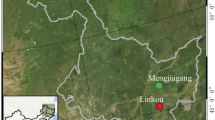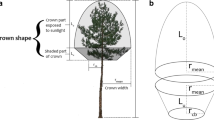Abstract
Key message
Crown width models developed using nonlinear simultaneous equations with a two-step procedure provided the best performance and are recommended to predict the crown components and crown width of Prince Rupprecht larch.
Abstract
Crown width (CW) is defined as an average of two crown diameters at two cardinal directions: east–west and south–north, obtained from measurements of four crown radii (crown components) at four directions: east, west, south, and north. CW is one of the important tree variables in forest growth and yield modeling, and forest management. Reliable estimates of CW are central elements of forest management. However, the additivity of CW and crown components and their inherent correlations have not been addressed in existing CW models. In this study, two alternative procedures for nonlinear simultaneous equations (NSE) were used to develop CW models. The procedures included a disaggregation model structure with one- and two-step, proportional weighting systems, and two commonly used additivity methods, adjustment in proportion (AP) and ordinary least squares with separating regression (OLSSR). These methods were compared using data from a total of 3369 Prince Rupprecht larch (Larix principis-rupprechtii Mayr.) trees in 116 permanent sample plots in northern China. It was found that these methods effectively ensured that the sum of the crown components was equal to twice the total CW. The NSE accounted for the inherent correlations among the crown components and CW. The CW models developed using the NSE with the two-step procedure provided the best performance, followed by the models developed with AP and OLSSR. This methodology can be adapted to develop a system of CW models for other tree species.




Similar content being viewed by others
References
Assman E (1970) The principles of forest yield studies. Pergamon Press, Oxford, p 506
Baldwin VC, Peterson KD (1997) Predicting the crown shape of loblolly pine trees. Can J For Res 27:102–107
Bi H, Turner J, Lambert MJ (2004) Additive biomass equations for native eucalypt forest trees of temperate Australia. Trees 18:467–479
Biging GS, Wensel LC (1990) Estimation of crown form for six conifer species of northern California. Can J For Res 20:1137–1142
Bragg DC (2001) A local basal area adjustment for crown width prediction. North J App For 18(1):22–28
Carroll RJ, Ruppert D, Stefanski LA, Crainiceanu CM (2006) Measurement error in nonlinear models: a modern perspective, 2nd edn. Chapman and Hall/CRC Press, Boca Raton
Carvalho JP, Parresol BR (2003) Additivity in tree biomass components of Pyrenean Oak (Quercus pyrenaica Willd.). For Ecol Manag 179:269–276
Dong L, Zhang L, Li F (2015) Developing additive systems of biomass equations for nine hardwood species in Northeast China. Trees 29:1149–1163
Dong L, Zhang L, Li F (2016) Developing two additive biomass equations for three coniferous plantation species in Northeast China. Forests. doi:10.3390/f7070136
Du J, Tang S, Wang H (2000) Update models of forest resource data for subcompartments in natural forest. Sci Silv Sin 36(2):26–32 (in Chinese with English abstract)
Fu L, Sun H, Sharma RP, Lei Y, Zhang H, Tang S (2013) Nonlinear mixed-effects crown width models for individual trees of Chinese fir (Cunninghamia lanceolata) in south-central China. For Ecol Manag 302:210–220
Fu L, Lei Y, Sun W, Tang S, Zeng W (2014) Development of compatible biomass models for trees from different stand origin. Acta Ecol Sin 34(6):1–10 (in Chinese with English abstract)
Fu L, Lei Y, Wang G, Bi H, Tang S, Song X (2016) Comparison of seemingly unrelated regressions with multivariate errors-in-variables models for developing a system of nonlinear additive biomass equations. Trees 30:839–857
Fu L, Sharma RP, Hao K, Tang S (2017a) A generalized interregional nonlinear mixed-effects crown width model for Prince Rupprecht larch in northern China. For Ecol Manag 384:369–373
Fu L, Zhang H, Sharma RP, Pang L, Wang G (2017b) A generalized nonlinear mixed-effects height to crown base model for Mongolian oak in northeast China. For Ecol Manage 384:34–43
Fuller WA (1987) Measurement error models. Wiley, New York
Gertner GZ (1990) The sensitivity of measurement error in stand volume estimation. Can J For Res 20:800–804
Ghosh S, Innes JL, Hoffmann C (1995) Observer variation as a source of error in assessments of crown condition through time. For Sci 41(2):235–254
Hao X, Yujun S, Xinjie W, Jin W, Yao F (2015) Linear mixed-effects models to describe individual tree crown width for China-Fir in Fujian Province, Southeast China. PLoS One 10(4):e0122257. doi:10.1371/journal.pone.0122257
Hasenauer H, Monserud RA (1996) A crown ratio model for Austrian forests. For Ecol Manag 84:49–60
Hasenauer H, Monserud RA (1997) Biased predictions for tree height increment models developed from smoothed ‘data’. Ecol Model 98:13–22
Hynynen J, Ojansuu R, Hö¨kä H, Siipilehto J, Salminen H, Haapala P (2002) Models for predicting stand development in MELA system. Research Papers 835. Finnish Forest Research Institute, p 116
Kangas AS (1998) Effect of errors-in-variables on coefficients of a growth model and on prediction of growth. For Ecol Manag 102:203–212
Kozak A (1970) Methods of ensuring additivity of biomass components by regression analysis. For Chron 46:402–404
Lindstrom MJ, Bates DM (1990) Nonlinear mixed effects models for repeated measures data. Biometrics 46:673–687
Marshall DD, Johnson GP, Hann DW (2003) Crown profile equations for stand-grown western hemlock trees in northwestern Oregon. Can J For Res 33(11):2059–2066
Monserud RA, Sterba H (1996) A basal area increment model for individual trees growing in even-and uneven-aged forest stands in Austria. For Ecol Manag 80(1–3):57–80
Nicholas NS, Gregoire TG, Zedaker SM (1991) The reliability of tree crown classification. Can J For Res 21:698–701
Oker-Blom P, Pukkala T, Kuuluvainen T (1989) Relationship between radiation interception and photosynthesis in forest canopies: effect of stand structure and latitude. Ecol Model 49:73–87
Omule AY (1980) Personal bias in forest measurement. For Chron 56(5):222–224
Parresol BR (1999) Assessing tree and stand biomass: a review with examples and critical comparisons. For Sci 45(4):573–593
Parresol BR (2001) Additivity of nonlinear biomass equations. Can J For Res 31:865–878
Power H, LeMay V, Berninger F, Sattler D, Kneeshaw D (2012) Differences in crown characteristics between black (Picea mariana) and white spruce (Picea glauca). Can J For Res 42:1733–1743
Pukkala T, Becker P, Kuuluvainen T, Oker-Blom P (1991) Predicting spatial distribution of direct radiation below forest canopies. Agric For Meteorol 55:295–307
Raulier F, Lambert M, Pothier D, Ung C (2003) Impact of dominant tree dynamics on site index curves. For Ecol Manag 184:65–78
Rencher AC, Schaalje GB (2008) Linear models in statistics, 2nd edn. Wiley, New York
Rozas V (2003) Tree age estimates in Fagus sylvatica and Quercus robur: testing previous and improved methods. Plant Ecol 167(2):193–212
Sánchez-González M, Cañellas I, Montero G (2007) Generalized height-diameter and crown diameter prediction models for cork oak forests in Spain. Invest Agrar: Sist Recur For 16(1):76–88
Sharma RP, Vacek Z, Vacek S (2016) Individual tree crown width models for Norway spruce and European beech in Czech Republic. For Ecol Manag 366:208–220
Sönmez T (2009) Diameter at breast height-crown diameter prediction models for Picea orientalis. Afr J Agric Res 4(3):215–219
Tang S, Li Y (2002) Statistical foundation for biomathematical models. Science Press, Beijing (in Chinese)
Tang S, Wang Y (2002) A parameter estimation program for the errors-in-variable model. Ecol Model 156(2–3):225–236
Tang S, Zhang S (1998) Measurement error models and their applications. J Biomath 13:161–166
Tang S, Zhang H, Xu H (2000) Study on establish and estimate method of compatible biomass model. Sci Silvae Sin 36:19–27 (in Chinese with English abstract)
Tang S, Li Y, Wang Y (2001) Simultaneous equations, errors-in-variable models, and model integration in systems ecology. Ecol Model 142(3):285–294
Tang SZ, Lang KJ, Li HK (2008) Statistics and computation of biomathematical models (ForStat Course). Science Press, Beijing (in Chinese)
Tang SZ, Li Y, Fu LY (2015) Statistical foundation for biomathematical models, 2nd edn. Higher Education Press, Beijing, p 435 (in Chinese)
Vonesh EF, Chinchilli VM (1997) Linear and nonlinear models for the analysis of repeated measurements. Marcel Dekker, New York
Zeng WS, Tang SZ (2010) Using measurement error modeling method to establish compatible single-tree biomass equations system. For Res 23(6):797–802 (in Chinese with English abstract)
Zhang Z (2008) Dendrology-the north, 2nd edn. China Forestry Publishing House, Beijing, p 550 (in Chinese)
Acknowledgements
We thank the Fundamental Research Funds for the Central Non-profit Research Institution of CAF (Grant No. CAFYBB2016SZ003), the Forestry Public Welfare Scientific Research Project of China (Grant No. 201404417) and the Chinese National Natural Science Foundations (Grant Nos. 31470641, 31300534, and 31570628) for financial support. We also appreciate the valuable comments and the constructive suggestions from two anonymous referees and the Associate Editor.
Author information
Authors and Affiliations
Corresponding author
Ethics declarations
Conflict of interest
The authors declare that they have no conflict of interest.
Additional information
Communicated by E. Priesack.
Rights and permissions
About this article
Cite this article
Fu, L., Xiang, W., Wang, G. et al. Additive crown width models comprising nonlinear simultaneous equations for Prince Rupprecht larch (Larix principis-rupprechtii) in northern China. Trees 31, 1959–1971 (2017). https://doi.org/10.1007/s00468-017-1600-0
Received:
Accepted:
Published:
Issue Date:
DOI: https://doi.org/10.1007/s00468-017-1600-0




